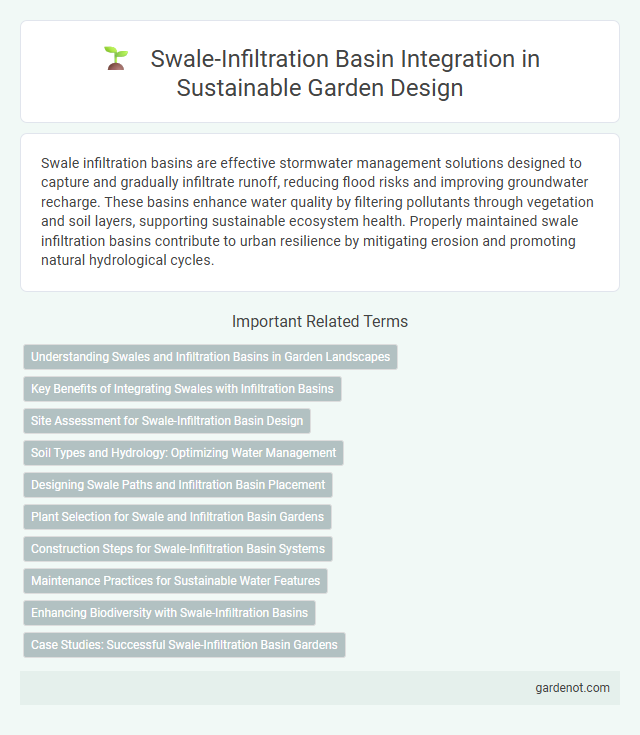Swale infiltration basins are effective stormwater management solutions designed to capture and gradually infiltrate runoff, reducing flood risks and improving groundwater recharge. These basins enhance water quality by filtering pollutants through vegetation and soil layers, supporting sustainable ecosystem health. Properly maintained swale infiltration basins contribute to urban resilience by mitigating erosion and promoting natural hydrological cycles.
Understanding Swales and Infiltration Basins in Garden Landscapes
Swale infiltration basins are designed to manage stormwater by directing runoff into shallow, vegetated channels that promote water infiltration and filtration. These systems mimic natural hydrological processes, reducing surface runoff while enhancing groundwater recharge and minimizing erosion. Integrating swales and infiltration basins in garden landscapes improves water quality, supports native plants, and contributes to sustainable water management practices.
Key Benefits of Integrating Swales with Infiltration Basins
Swale-infiltration basins enhance stormwater management by combining the swale's natural water conveyance with infiltration basins' capacity to promote groundwater recharge and reduce surface runoff. This integration improves pollutant removal efficiency by facilitating sedimentation, filtration, and microbial breakdown within the swale before water reaches the infiltration basin. Additionally, the combined system mitigates flood risks, supports urban green infrastructure goals, and helps maintain local hydrological cycles through increased water retention and groundwater replenishment.
Site Assessment for Swale-Infiltration Basin Design
Site assessment for swale-infiltration basin design requires detailed evaluation of soil permeability, slope gradient, and existing hydrology to ensure effective water infiltration and runoff management. Soil tests such as percolation rates and particle size distribution determine infiltration capacity and help prevent basin failure due to clogging or oversaturation. Accurate topographic mapping and groundwater level monitoring also guide basin placement and size to optimize stormwater capture and groundwater recharge.
Soil Types and Hydrology: Optimizing Water Management
Swale-infiltration basins perform optimally in sandy loam and loam soils, which facilitate efficient water percolation and reduce surface runoff. Properly assessing soil permeability and infiltration rates ensures enhanced groundwater recharge and minimizes erosion risks. Hydrologically, these basins balance stormwater retention and infiltration, promoting sustainable water management in urban and suburban landscapes.
Designing Swale Paths and Infiltration Basin Placement
Designing swale paths involves aligning contours to maximize water capture and promote gradual infiltration while minimizing erosion risks. Infiltration basin placement should target low-permeability zones adjacent to swales to enhance stormwater management and recharge groundwater efficiently. Proper integration of swale paths with strategically located infiltration basins optimizes runoff retention and reduces surface flooding.
Plant Selection for Swale and Infiltration Basin Gardens
Selecting appropriate plants for swale and infiltration basin gardens enhances water filtration and erosion control while supporting local biodiversity. Native grasses, sedges, and wetland species like Carex, Juncus, and Pontederia thrive in fluctuating moisture conditions and improve soil stabilization. Deep-rooted perennials such as Echinacea and Asclepias promote infiltration efficiency by maintaining soil structure and facilitating groundwater recharge.
Construction Steps for Swale-Infiltration Basin Systems
Constructing a swale-infiltration basin system involves grading the site to create a gently sloping swale that directs runoff towards a designated infiltration basin. Installing soil amendments and permeable materials enhances infiltration rates, while establishing vegetation with deep root systems stabilizes soil and promotes water absorption. Final steps include integrating erosion control measures and monitoring infrastructure to ensure effective stormwater management and groundwater recharge.
Maintenance Practices for Sustainable Water Features
Regularly removing sediment and debris from Swale-infiltration basins enhances water absorption and prevents clogging, ensuring long-term functionality. Vegetation management through selective planting and periodic trimming supports infiltration rates while stabilizing soil and reducing erosion. Inspecting and repairing any structural damage promptly maintains the integrity of the basin, promoting sustainable stormwater management and groundwater recharge.
Enhancing Biodiversity with Swale-Infiltration Basins
Swale-infiltration basins significantly enhance biodiversity by creating diverse wetland habitats that support a wide range of aquatic and terrestrial species. These basins improve water quality through natural filtration, promoting healthy plant growth and providing essential resources for pollinators and wildlife. Integrating vegetation with variable hydrological conditions in swale-infiltration systems fosters ecological resilience and habitat connectivity in urban and suburban landscapes.
Case Studies: Successful Swale-Infiltration Basin Gardens
Swale-infiltration basin gardens effectively manage stormwater runoff by combining vegetated swales with infiltration basins to enhance groundwater recharge and reduce surface flooding. Case studies from urban areas like Portland, Oregon demonstrate how these systems improve water quality by filtering pollutants and mitigating peak flow during heavy rain events. Research shows that maintenance practices such as sediment removal and vegetation management are crucial for sustaining infiltration rates and long-term performance.
Swale-infiltration basin Infographic

 gardenot.com
gardenot.com